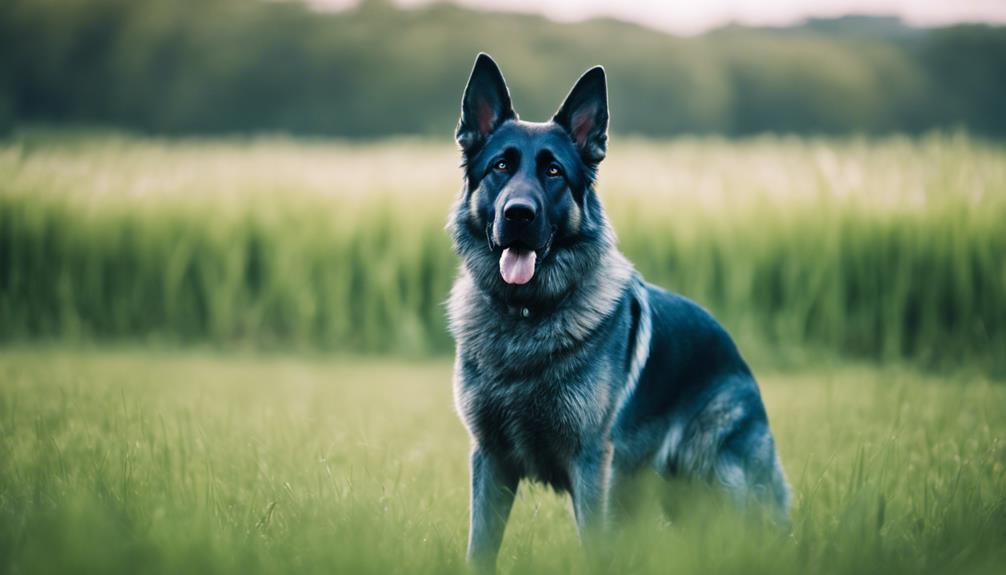🐾 Paw-some Partnership Alert! 🐾
As a pack of German Shepherd enthusiasts at MixGermanShepherd.com, we're always sniffing out the best products for our furry friends. Guess what? When you fetch something from Amazon through our links, we earn a little treat! 🦴
Did you know that only a small percentage of German Shepherds are born with the rare blue coat coloration? The Blue German Shepherd breed is not only visually striking but also possesses unique characteristics that set them apart from the standard GSDs. Understanding their origins, temperament, and specific care requirements is essential for potential owners looking to welcome one into their home. Stay tuned to discover the fascinating details about the Blue German Shepherd breed and what makes them such special companions in the world of canine enthusiasts.
Key Takeaways
- Blue German Shepherds have a distinct blue coat color from a recessive gene.
- They are known for their loyalty, protectiveness, and family-oriented behavior.
- Training them is highly effective with positive reinforcement and consistency.
- Proper care, grooming, and health monitoring are crucial for their well-being and longevity.
Blue German Shepherd Origins
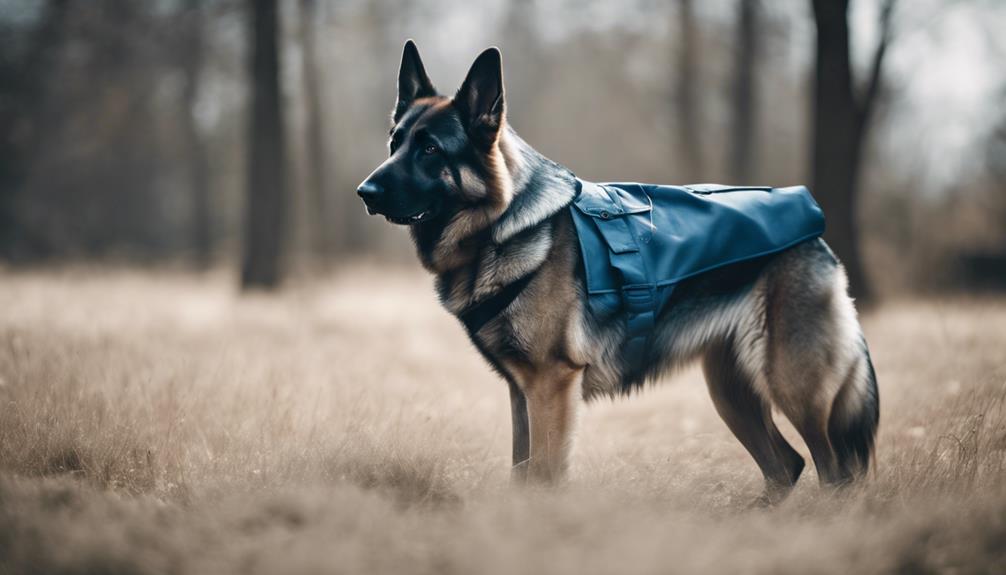
Blue German Shepherd origins can be traced back to Germany in the late 19th century when they were developed as working dogs for herding and guarding sheep. The breeding of these dogs was focused on creating intelligent, agile, and loyal companions capable of handling the demanding tasks associated with herding livestock. The distinctive blue coat color seen in some German Shepherds is a result of a recessive gene that affects the pigmentation of the fur, giving rise to the unique appearance that sets them apart from the traditional tan and black coloration of the breed.
The introduction of the blue German Shepherd to the United States in 1907 marked the beginning of their journey to becoming recognized for their exceptional skills and adaptability. Despite the controversy surrounding the breeding practices aimed at producing blue-coated individuals, it is essential to remember that the underlying characteristics and behavioral traits of these dogs remain consistent with those of standard German Shepherds. This breed is known for its unwavering loyalty, intelligence, and dedication to any task assigned to them, making them valuable assets in various roles such as search and rescue, police work, and service assistance.
Physical Characteristics of Blue German Shepherds
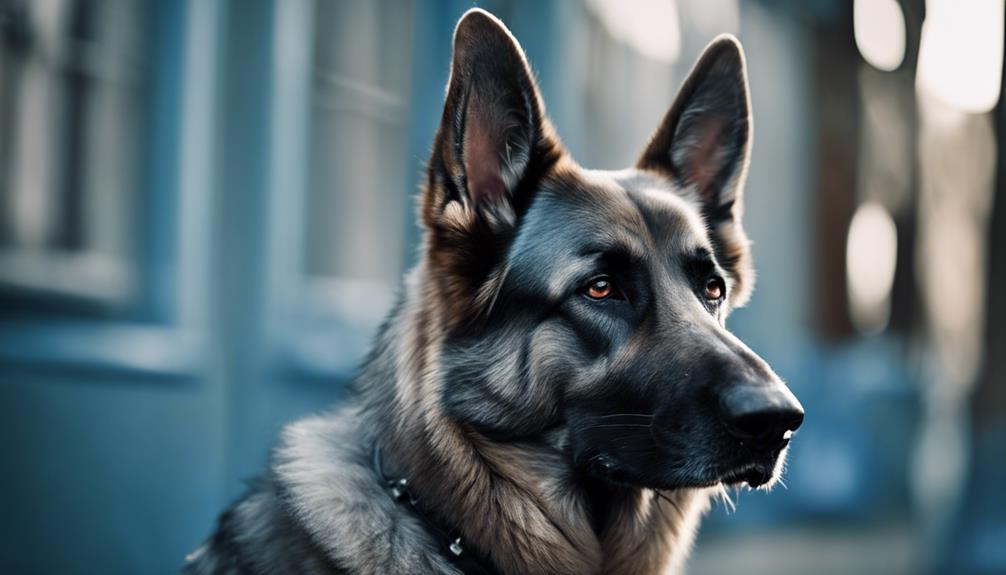
Originating from Germany in the late 19th century, the physical characteristics of the Blue German Shepherd breed showcase a distinctive blend of size, coat color, and grooming requirements that set them apart from their traditional counterparts.
- Blue German Shepherds are large dogs, with males standing 22-26 inches tall and females 22-24 inches.
- They typically weigh between 55-95 pounds, with males being heavier than females.
- Blue German Shepherds have a distinct blue-gray coat color, which is a rare variation in the breed.
- Their coat is thick, dense, and medium in length, requiring regular grooming to manage shedding.
- Blue German Shepherds may exhibit variations like blue and tan, blue merle, blue brindle, and blue fawn in their coat colors.
The blue coat color of these dogs is a result of a recessive gene that dilutes the traditional black color seen in standard German Shepherds. This unique coloration adds to the allure of the Blue German Shepherd breed, making them stand out in a crowd. Their size and coat density make them well-suited for various climates, although they may require more attention during shedding seasons due to their thick fur. Understanding the physical characteristics of Blue German Shepherds is essential for properly caring for and appreciating these majestic canines.
Temperament and Behavior
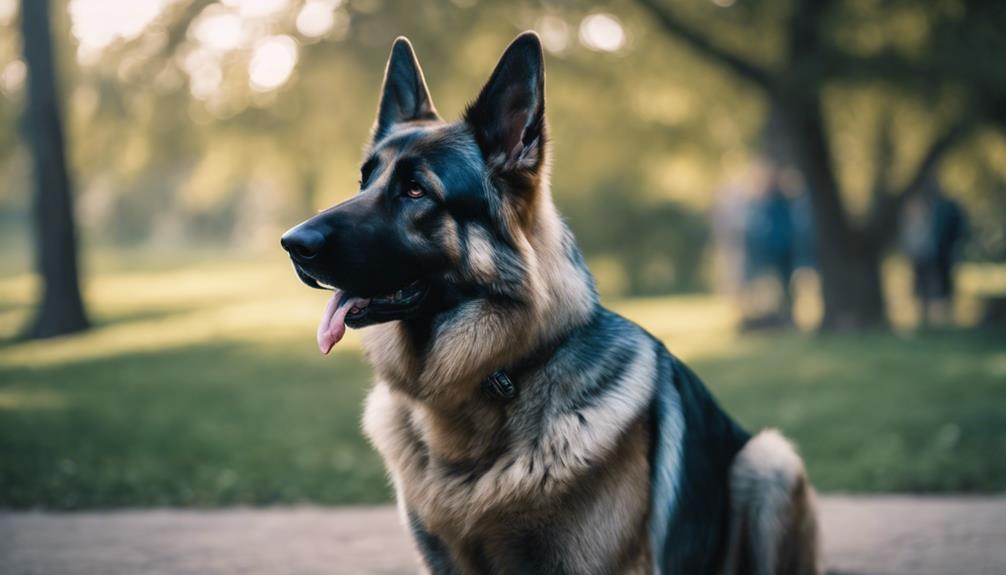
Blue German Shepherds exhibit traits like loyalty, protectiveness, and vigilance, which contribute to their suitability as guard dogs. Training and socialization are crucial in fostering a strong bond and ensuring proper behavior in these energetic and large dogs. Understanding their behavioral characteristics can help create a harmonious relationship with your Blue German Shepherd.
Traits and Characteristics
In understanding the temperament and behavior of the German Shepherd breed, it is crucial to recognize their innate loyalty and protective instincts. Blue German Shepherds exhibit distinct traits and characteristics that set them apart:
- Devotion: They are incredibly devoted and family-oriented.
- Vigilance: Known for being vigilant and cautious, they make excellent guard dogs.
- Socialization: Proper socialization is essential for forming strong bonds and understanding their protective instincts.
- Activity: Energetic and active, they require regular physical and mental stimulation.
- Trainability: Their intelligence and responsiveness to positive reinforcement methods enhance their ability to learn and follow commands effectively.
These traits make Blue German Shepherds unique companions with the potential to thrive in the right environment.
Training and Socialization
Proper training and socialization play pivotal roles in shaping the temperament and behavior of Blue German Shepherds. These dogs are highly trainable, responding well to positive reinforcement methods, making obedience training effective. Early socialization is essential to ensure they interact positively with children, pets, and strangers, given their loyal and protective nature. Blue German Shepherds are known for their cautious yet alert demeanor, often acting as vigilant companions. Their loyalty is a defining trait, emphasizing the importance of nurturing a strong bond through consistent training and social exposure. This breed excels in tasks that engage their intelligence and physical abilities, requiring mental and physical stimulation to prevent boredom and maintain their well-being.
| Training | Socialization | Loyalty |
|---|---|---|
| Obedience training | Early socialization | Strong bond |
Trainability of Blue German Shepherds
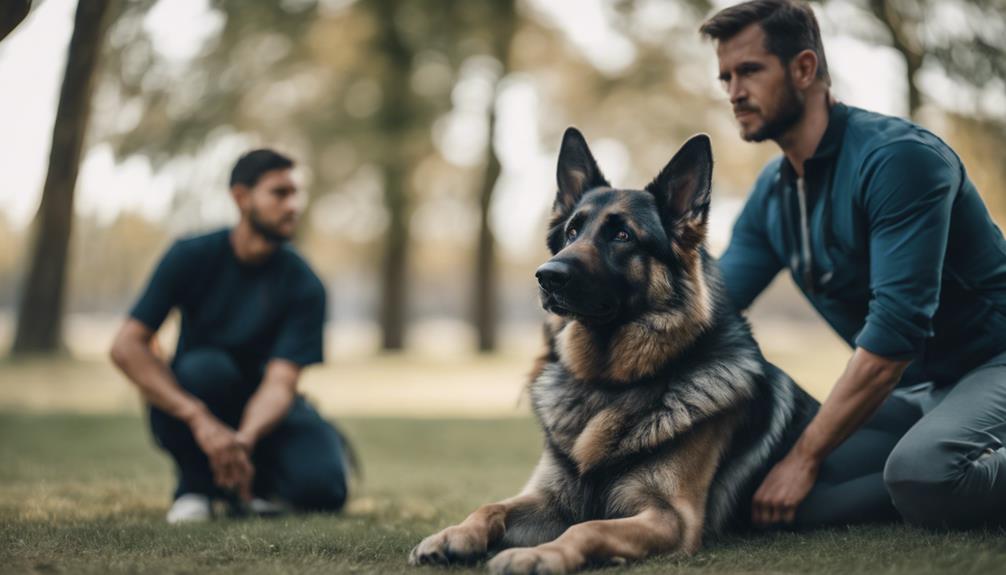
Blue German Shepherds exhibit a remarkable capacity for learning and responding positively to training techniques. Their high level of intelligence enables them to grasp commands quickly and efficiently. To optimize their training experience, engaging and mentally stimulating sessions are essential to maintain their focus and motivation.
Training Methods for Blues
Utilize reward-based training techniques to effectively enhance the trainability of Blue German Shepherds, capitalizing on their high intelligence and receptiveness to positive reinforcement. Blue German Shepherds respond well to positive reinforcement methods, making training a rewarding experience for both you and your canine companion. When training your Blue German Shepherd, remember the importance of socialization from an early age to ensure they interact well with various individuals and animals. Additionally, incorporating mental stimulation activities into their training regimen can help boost their learning capabilities. Prioritize physical exercise before training sessions to improve focus and performance. Tailoring your training approach to align with these key factors will maximize the potential of your Blue German Shepherd.
- Use positive reinforcement methods
- Prioritize socialization
- Incorporate mental stimulation activities
- Include physical exercise before training
- Tailor training approach to individual needs
Behavioral Challenges and Solutions
What behavioral challenges may arise when training Blue German Shepherds and how can they be effectively addressed to enhance their trainability? Blue German Shepherds, despite their intelligence, can exhibit challenges related to their protective instincts and energy levels. To address these, utilizing positive reinforcement training methods tailored to their individual needs is essential. Proper socialization from an early age helps manage their protective instincts, ensuring they respond well to commands. Incorporating regular exercise routines before training sessions can help channel their energy in a positive direction, improving focus and overall training outcomes. By understanding and working with their natural instincts and energy levels, you can enhance the trainability of Blue German Shepherds effectively.
| Challenges | Solutions |
|---|---|
| Protective instincts | Proper socialization from a young age |
| High energy levels | Regular exercise before training sessions |
| Individualized training methods tailored to the dog | Positive reinforcement |
Exercise Requirements for Blue German Shepherds
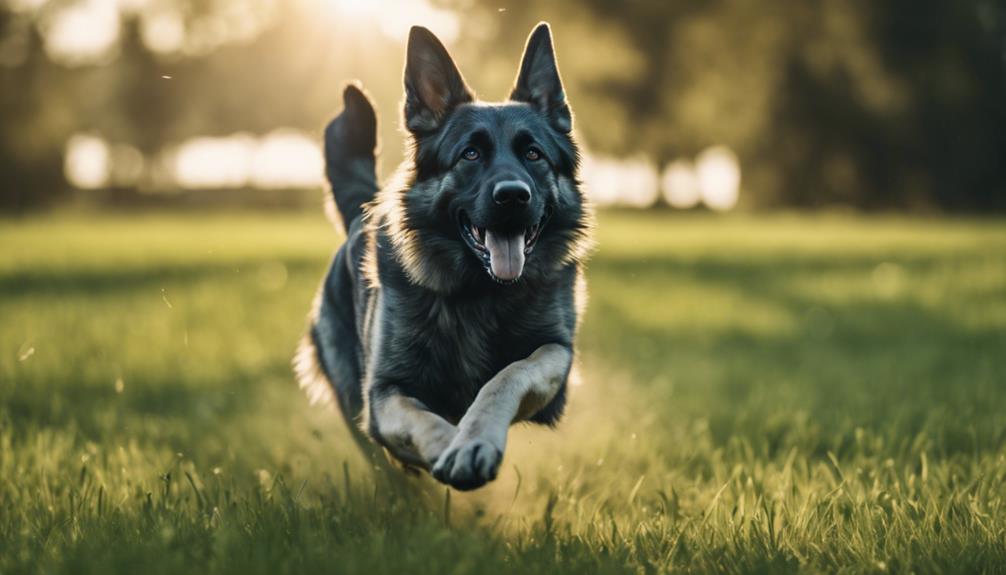
To maintain the physical health and well-being of Blue German Shepherds, it is crucial to ensure they receive a minimum of 60 to 90 minutes of daily exercise. Blue German Shepherds, like their traditional counterparts, have specific needs when it comes to physical exercise and mental stimulation. Here are some key points to consider:
- Blue German Shepherds require a minimum of 60 to 90 minutes of daily exercise to stay healthy and happy.
- They enjoy various physical activities such as walking, running, hiking, and playing fetch.
- Regular exercise helps prevent obesity, strengthens muscles, and improves their overall well-being.
- Tailoring exercise routines to their energy levels and age is essential for their physical health.
- Engaging in interactive play sessions and mental stimulation games can also fulfill their exercise needs.
Meeting these exercise requirements is vital for the overall well-being of your Blue German Shepherd. By incorporating a mix of physical activities and mental challenges into their daily routine, you can help them stay healthy, happy, and mentally stimulated. Remember, a well-exercised Blue German Shepherd is a content companion.
Socialization Needs
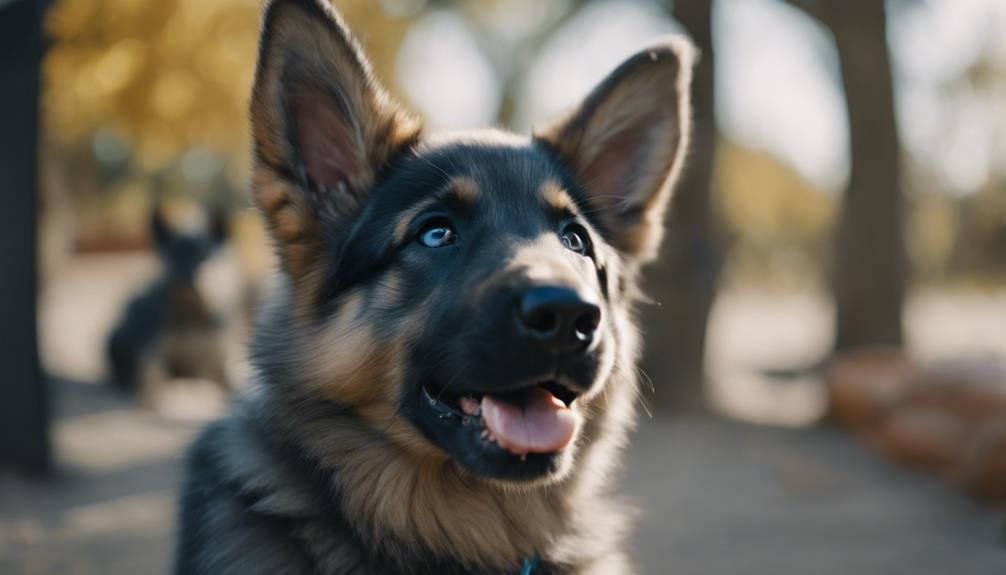
Proper socialization plays a vital role in shaping the behavior and adaptability of Blue German Shepherds from a young age. Socialization refers to the process of exposing dogs to various stimuli like different situations, people, animals, and environments in a controlled and positive manner. This exposure helps Blue German Shepherds become well-rounded and confident individuals, capable of navigating different scenarios without fear or aggression.
Failure to adequately socialize Blue German Shepherds can lead to behavioral issues such as fear-based aggression and nervous behaviors. Early and consistent socialization is key in preventing problems like separation anxiety and aggression towards strangers. By engaging in regular, positive interactions with other dogs and people, Blue German Shepherds learn to be friendly, well-mannered, and adaptable in diverse settings.
It is important to note that socialization should be a continuous process throughout the dog's life. Positive experiences during the critical developmental periods, typically between 3 to 14 weeks of age, are particularly influential in shaping the dog's behavior and responses to stimuli. Therefore, investing time and effort in socializing your Blue German Shepherd effectively can significantly contribute to their overall well-being and long-term behavioral health.
Grooming Tips for Blue German Shepherds
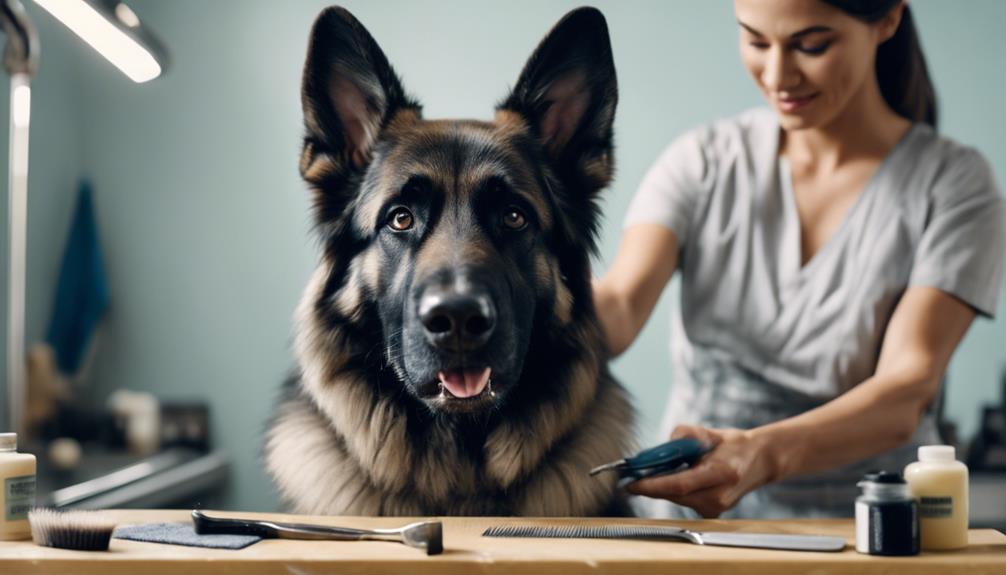
To maintain your Blue German Shepherd's coat health, regular brushing is crucial in managing shedding. Consider scheduling occasional grooming salon visits to keep their appearance well-maintained. Furthermore, essential care practices like nail clipping, teeth cleaning, and ear inspections are vital for their overall hygiene.
Coat Care Essentials
Regular brushing is essential for managing shedding and maintaining the coat health of Blue German Shepherds with double coats. To ensure your Blue German Shepherd's coat remains healthy and vibrant, follow these grooming tips:
- Brush your dog's coat at least 2-3 times a week to remove loose fur and prevent matting.
- Use a slicker brush or undercoat rake to reach the dense undercoat and detangle any knots gently.
- Trim your dog's nails regularly to prevent overgrowth and discomfort while walking.
- Clean your dog's ears weekly to avoid infections and check for any signs of redness or irritation.
- Brush your dog's teeth regularly to prevent dental issues and maintain overall oral health.
Bathing Frequency Recommendations
For optimal coat health and skin care of Blue German Shepherds, adhere to specific bathing frequency recommendations to prevent stripping their natural oils. Blue German Shepherds should be bathed no more than once a month using a mild canine shampoo to avoid skin irritation or dryness. Regular grooming, including brushing and trimming long hair around the eyes and ears, is crucial for managing shedding and preventing matting. By following a consistent grooming routine, you can maintain your Blue German Shepherd's overall hygiene and appearance effectively.
| Bathing Frequency | Grooming Tips |
|---|---|
| Once a month | Use mild canine shampoo |
| Regular brushing | |
| Trim long hair around eyes |
Health Considerations
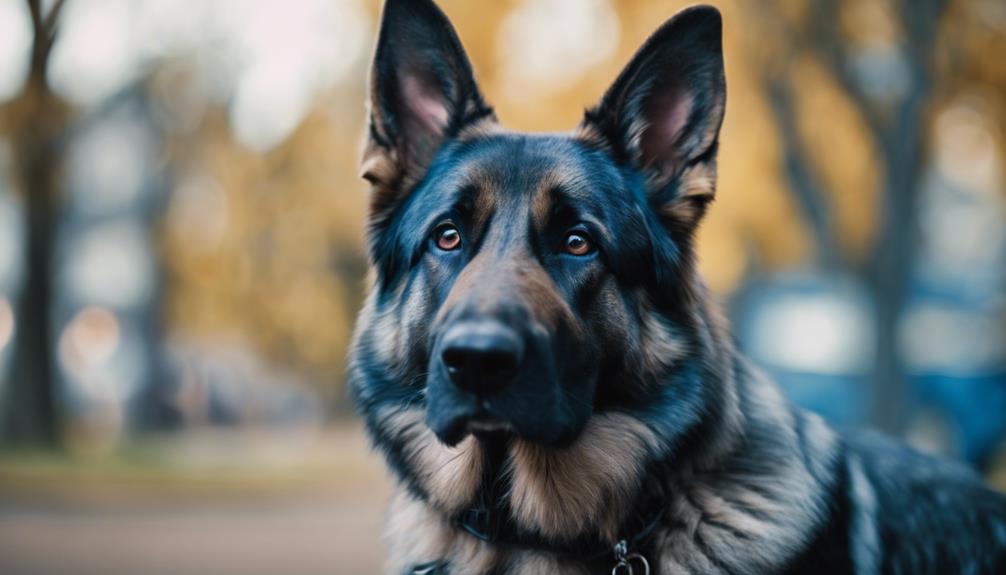
Health issues commonly affecting Blue German Shepherds include hip and elbow dysplasia, bloat, aortic stenosis, diabetes, bladder stones, cataracts, and thyroid problems. To ensure the well-being of your Blue German Shepherd, it is crucial to address these health considerations proactively. Here are some key points to keep in mind:
- Proper Diet: Providing a balanced and nutritious diet is essential in managing potential health issues like diabetes and bladder stones. Consult with your veterinarian to determine the best diet for your Blue German Shepherd's specific needs.
- Regular Exercise: Engaging in regular physical activity is vital for maintaining healthy joints and preventing conditions like hip and elbow dysplasia. Daily exercise helps in managing weight, promoting cardiovascular health, and enhancing overall well-being.
- Routine Veterinary Check-ups: Regular visits to the vet can help in early detection and management of health problems such as aortic stenosis, cataracts, and thyroid issues. Health clearances are also important when considering breeding your Blue German Shepherd.
- Insurance Coverage: Consider investing in health insurance to cover potential medical expenses. This can provide financial protection and peace of mind in case your Blue German Shepherd requires unexpected medical attention.
- Careful Breeder Selection: Choosing a reputable breeder who prioritizes the health and genetic well-being of their dogs can help reduce the risk of inherited health issues in your Blue German Shepherd.
Dietary Needs of Blue German Shepherds

Blue German Shepherds' dietary requirements are crucial for their optimal health and energy levels, necessitating a daily intake of approximately 20 calories per pound. To meet these needs, it is recommended to provide them with high-quality dry kibble. This type of diet offers the necessary balance of nutrients to support their overall well-being.
When feeding Blue German Shepherd puppies, it is advisable to offer meals 3-4 times a day to sustain proper growth and development. As they mature into adults, transitioning to a feeding schedule of twice daily helps maintain their nutritional requirements. Additionally, incorporating meat and cooked vegetables into their diet can supply essential nutrients and add variety to their meals.
It is vital to be mindful of the quantity of food provided to Blue German Shepherds to avoid overfeeding. Checking food packaging for the recommended daily calorie intake based on their weight and activity level can help prevent obesity and associated health issues. By adhering to a balanced diet and monitoring their food intake, you can ensure that your Blue German Shepherd stays healthy and energetic.
Common Health Issues in Blue German Shepherds

Prone to various health issues, German Shepherds with the blue coat coloration require attentive care and proactive measures to maintain their well-being. It is crucial to be aware of the common health problems that Blue German Shepherds may face to ensure they lead a healthy and fulfilling life. Here are some key health issues to watch out for:
- Hip Dysplasia: This is a common genetic condition in Blue German Shepherds where the hip joint doesn't fit properly into the socket, leading to pain and lameness.
- Balanced Diet: Providing a well-rounded and appropriate diet is essential for managing weight and preventing health issues like obesity, which can exacerbate joint conditions.
- Regular Vet Check-ups: Scheduled veterinary visits are crucial for early detection and management of any potential health concerns, ensuring your Blue German Shepherd receives timely care.
- Exercise: Adequate physical activity is vital for maintaining muscle strength, joint health, and overall well-being. Regular exercise can help prevent obesity and alleviate joint problems.
- Preventative Measures: Taking proactive steps, such as providing supplements recommended by your vet, can help mitigate the risk of certain health issues commonly seen in Blue German Shepherds.
Lifespan and Popularity of Blue German Shepherds
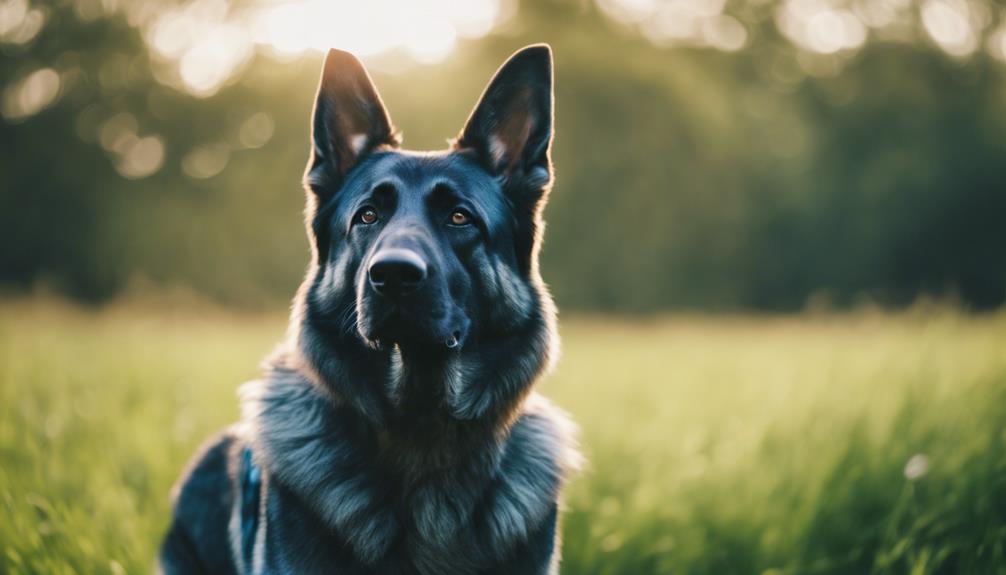
With an average lifespan of 10-14 years, the popularity of Blue German Shepherds has been on the rise due to their unique coat color and distinct appearance. Their longevity is influenced by factors such as maintaining a healthy weight range and caring for their double coats, which come in shades of blue. Responsible breeding practices play a crucial role in ensuring the quality and health of Blue German Shepherds. Professional breeders should prioritize genetic testing and veterinary care to promote the well-being of these dogs.
The lifespan of Blue German Shepherds is comparable to that of standard German Shepherds, highlighting the importance of proper care and attention to maximize their years. By adhering to responsible breeding practices, breeders can help mitigate potential health issues and genetic predispositions, ultimately contributing to the longevity of Blue German Shepherds. As these dogs continue to gain popularity among enthusiasts and families alike, it is imperative that breeders uphold ethical standards in their practices to preserve the breed's well-being and unique characteristics. Through a combination of proper care, genetic testing, and responsible breeding, the lifespan and popularity of Blue German Shepherds can be sustained for generations to come.
Frequently Asked Questions
What Is a Blue German Shepherd Breed?
A Blue German Shepherd breed is characterized by a distinct blue coat resulting from unique genetics. Beyond their appearance, these dogs are known for their loyal and family-oriented temperament traits, making them excellent guard dogs.
Does AKC Recognize Blue German Shepherds?
Yes, the AKC does recognize Blue German Shepherds. However, the blue coat color is considered a fault and not endorsed for breeding. Due to breeding standards favoring traditional colors, blue German Shepherds face limitations in conformation events.
How Rare Is a Blue Gsd?
Blue German Shepherds are rare due to coat genetics. Breeders are attracted to their uniqueness, impacting popularity. Health implications are minimal. Finding a reputable breeder can be harder due to rarity, leading to higher demand and prices.
Are Blue German Shepherds Hypoallergenic?
If you're hoping for a hypoallergenic pup, a Blue German Shepherd might not be the best fit. Their shedding and dander can trigger allergies. Regular grooming can help, but it may not fully eliminate allergens.
Conclusion
In conclusion, Blue German Shepherds are a fascinating breed known for their unique blue-gray coat and exceptional qualities. Interestingly, a study found that Blue German Shepherds are ranked among the top 10 most popular dog breeds in the United States. Their intelligence, loyalty, and protective nature make them excellent companions for families and individuals alike. With proper care, training, and socialization, Blue German Shepherds can thrive and bring joy to their owners for many years to come.
